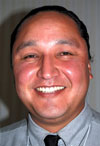Notice:
This website constitutes an historical record of the MRRIC Charter Planning
Group Process, which ended July 2008. For current information about the MRRIC stakeholder
process, including how to apply for membership on the Committee, please go to http://www.mrric.org.
Mike Catches Enemy
Oglala Sioux Tribe

Michael Catches Enemy is representing the Oglala Sioux Tribe of the Pine Ridge Indian Reservation, South Dakota, where he serves as Natural Resources Director of the Oglala Sioux Tribe Natural Resources Regulatory Agency.
He was appointed to the Missouri River Recovery and Implementation Committee (MRRIC) by the Oglala Sioux Tribe Executive Committee who issued Resolution No. 07-30XB. The resolution reads as follows:
RESOLUTION OF THE EXECUTIVE COMMITTEE OF THE OGLALA SIOUX TRIBE TO DESIGNATE MIKE CATCHES ENEMY AS THE OGLALA SIOUX TRIBE’S REPRESENTATIVE ON THE MISSOURI RIVER IMPLEMENTATION COMMITTEE (MRRIC) ADVISORY GROUP PROCESS.
Mr. Johnson Holy Rock and Mr. Harvey White Woman who are both Indian Water and Treaty Rights advocates have been designated by the Executive Committee to serve as Michael’s alternates to the MRRIC Planning Group. Johnson Holy Rock is a former President of the Sioux Tribe and Oglala Sioux Tribe Fifth Member. Mr. Harvey White Woman is the former Administrative Assistant in the Oglala Sioux Tribe Fifth Member’s Office.
Mr. Catches Enemy has served as Natural Resources Director for the Oglala Sioux Tribe since May of 2004. His responsibilities include administering P.L. 93-638 contracts and the tribe’s contract with the U.S. Army Corps of Engineers. As Natural Resources Director he also identifies, updates and develops legislation for the protection, conservation and management of natural and water resources. He enforces tribal environmental and natural resources laws and ensures that Oglala Sioux Tribe water rights are protected and advocated for, as provided by the 1851 and 1868 Treaties and its boundaries, including the Pine Ridge reservation. He complies with all Oglala Sioux Tribe and federal reporting requirements.
Michael earned a B.S. in Environmental Science from Oglala Lakota College Department of Math and Science in Kyle, South Dakota in May of 2003, and has earned graduate credits toward a Master of Science. He also earned credits from Colorado State University’s Department of Natural Resources from January 2000 to December 2001, when he transferred to Oglala Lakota College. He received his high school diploma from Red Cloud High School in Pine Ridge, South Dakota, May of 1989.
WHY MICHAEL IS A REPRESENTATIVE ON THIS COMMITTEE:
The Oglala Sioux Tribe Executive Committee recognized that discussions of the establishment of the multi-stakeholder advisory group in the course of the Endangered Species Act consultations were going to be held and that it was in the best interest of the Oglala Sioux Tribe to be at the table to protect the treaty rights and property interests in the Missouri River and its tributaries. The Oglala Sioux Tribe is an important stakeholder that still holds valuable property rights to the waters and land comprising the Missouri River and its tributaries, including unquantified Winter’s Doctrine water rights, hunting and fishing rights, usu-fructuary rights to human remains and cultural items along the banks of the Missouri River and its tributaries under NAGPRA, ARPA, and NHPA, and still has a valid claim to the ownership of the bed of the Missouri River, all of which are guaranteed under the 1851 and 1868 Ft. Laramie Treaties and the Fifth Amendment to the United States Constitution.
As a Tribal Member of the Oglala Sioux Tribe and a resident here on the Pine Ridge Reservation, personal history as it relates to the Missouri River includes being a part of the “Big Muddy”, as this is part of the aboriginal territory and waters of my people and ancestors. Our relationship to and with the Missouri River includes, but is not limited to, conducting hunting, fishing, berry and plant harvesting, as well as utilizing as encampments, for various cultural ceremonies and burial sites.
For comments or questions about this website, please contact:
usiecr@ecr.gov.
This page was last updated 7/17/2019.